Salesforce, Inc. is an American technology company headquartered in San Francisco, recognized as a global leader in the Customer Relationship Management (CRM) software segment. Through a consistent development strategy, numerous acquisitions, and innovations in artificial intelligence and data, the company has established itself as one of the most important players in the business software sector.
Salesforce’s business model is based on offering an integrated cloud application platform for enterprises, available on a subscription basis. This means customers pay a monthly or annual fee for access to selected Salesforce system modules such as sales management, customer service, marketing, e-commerce, and data analytics tools. This recurring revenue model provides the company with high financial predictability, customer loyalty, and great flexibility in scaling the business.
At the core of the offering is Salesforce Customer 360, a comprehensive platform that integrates customer data from various organizational touchpoints. Salesforce solutions are used by both small businesses and global corporations. Thanks to a modular approach and a developed partner ecosystem (AppExchange), users can customize the system to their industry and operational needs.
Salesforce Product Portfolio
Salesforce offers a comprehensive cloud platform integrating various solutions dedicated to customer relationship management and digital transformation of enterprises. The key components of the portfolio include:
-
Sales Cloud – a tool supporting sales teams in managing leads, pipelines, and sales forecasting.
-
Service Cloud – a customer service module enabling automation of cases, management of multichannel communication, and improving support quality.
-
Marketing Cloud – a platform for creating personalized marketing campaigns, process automation, and customer behavior analysis.
-
Commerce Cloud – a solution for businesses engaged in online sales, allowing integration of B2B and B2C channels and management of the customer experience.
-
Tableau – a data visualization and analytics tool enabling quick business decisions based on comprehensive reports.
-
MuleSoft – a platform that integrates different systems and applications, facilitating data flow and process automation across the organization.
-
Slack – a communication and team collaboration environment that integrates with other Salesforce products to enhance team productivity.
-
Einstein AI – a set of artificial intelligence tools built into the platform, supporting sales prediction, process automation, and personalized customer service.
-
Agentforce – a modern AI solution for customer service and task automation, gaining popularity and already used in many organizations.
Salesforce’s Entry into the National Security Sector
Responding to growing demand for advanced technologies in defense and intelligence sectors, Salesforce launched a new business unit called Missionforce. Its goal is to integrate artificial intelligence into key defense processes such as personnel management, logistics, and decision-making in U.S. government agencies and armed forces.
Missionforce aims to leverage Salesforce’s expertise in cloud solutions and AI platforms to modernize defense operations, enabling faster, more efficient, and smarter action. A key product in this area is Government Cloud Premium, a cloud environment dedicated to government agencies and intelligence services.
Salesforce’s entry into the national security sector via Missionforce opens the door to entirely new, strategically important market areas. Government contracts, especially with the U.S. administration and the Pentagon, are worth tens of billions of dollars and could become a significant revenue source. Moreover, increasing investments in cybersecurity and defense technologies by other countries create additional international expansion opportunities for Salesforce as a provider of advanced software in the security sector.
Competition and Market Environment
The cloud software market for business, especially in CRM, is growing rapidly and is highly competitive. This growth is driven by companies’ increasing need for digital transformation and the integration of advanced technologies such as AI. The global CRM market is estimated to be worth tens of billions of dollars and is expected to grow steadily at around 15% annually, becoming a key segment in enterprise development strategies worldwide.
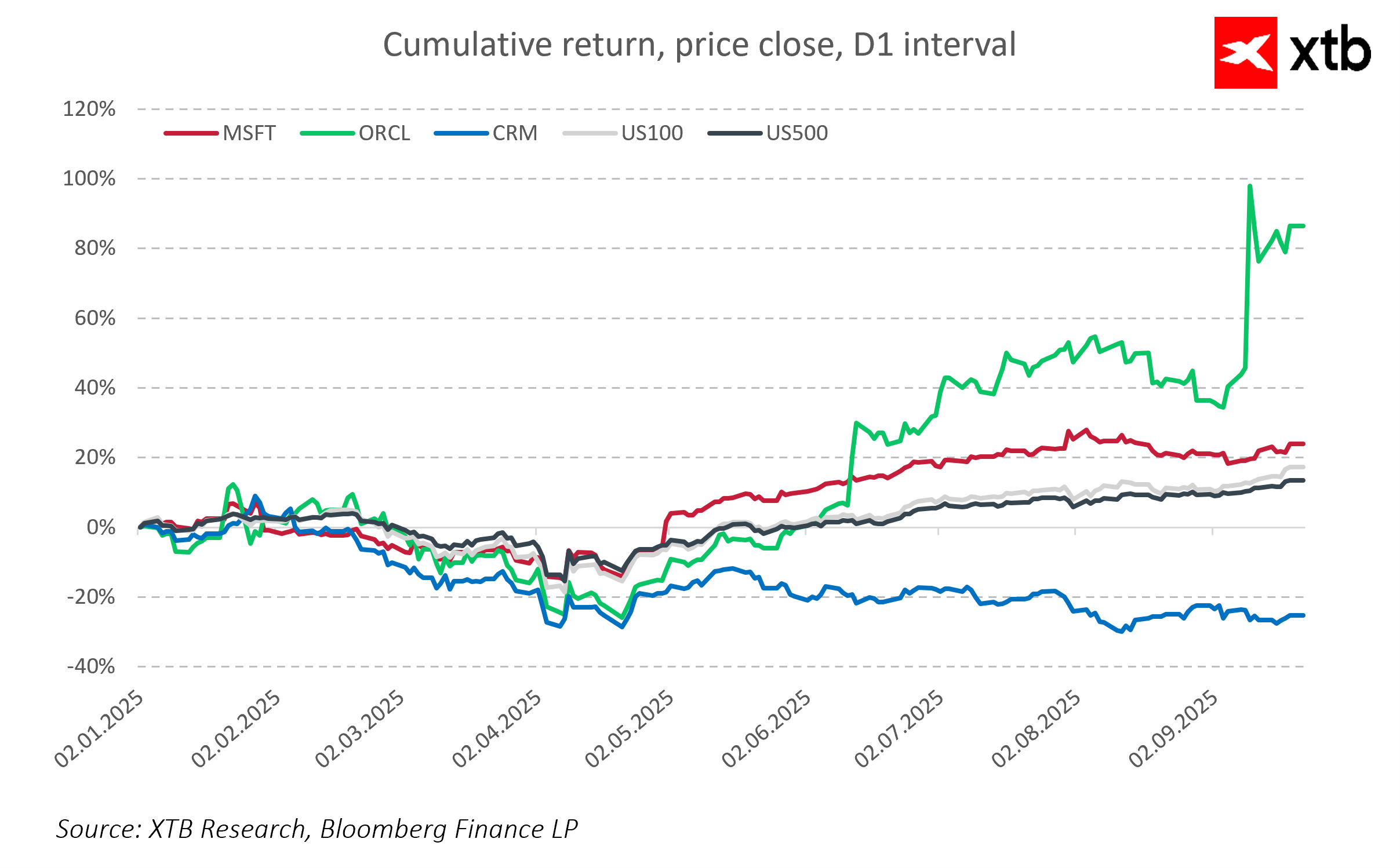
Salesforce’s main competitor is Microsoft with its Dynamics 365 product, which, thanks to integration with the popular Microsoft 365 suite and Azure platform, poses a serious challenge, especially for corporate and mid-sized customers. Microsoft offers a broad range of tightly integrated business applications, a significant advantage for many users. Another major rival is Oracle, focusing on integrated cloud solutions for large enterprises and developing its CRM with an emphasis on analytics and AI.
In 2025, despite Salesforce’s strong technological position, it struggled to convince investors that its AI investments and new areas like the defense sector (e.g., Missionforce) would quickly deliver better financial results. Consequently, its stock price declined, while competitors like Oracle and Microsoft better capitalized on rising demand for AI and cloud solutions, leading to growth in their valuations and revenues. However, such a gap in returns may suggest Salesforce is undervalued, especially if it begins to effectively monetize new business areas and accelerate AI integration in its products. Entry into the national security market opens new growth and revenue prospects.
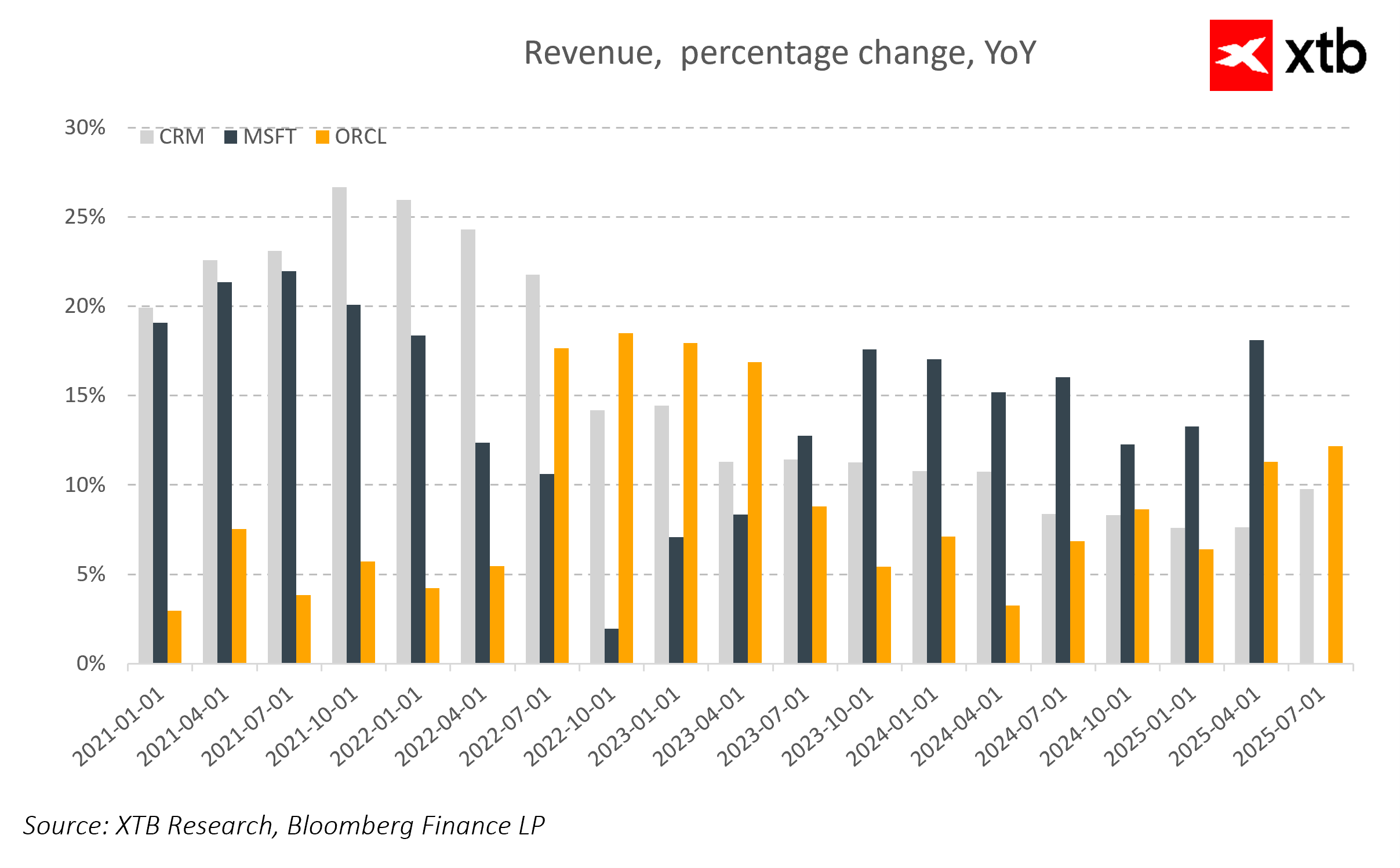
Salesforce’s revenue growth slowed significantly after a strong period in 2021–2022, when growth exceeded 25%. Currently, the company reports growth below 10%, trending toward stabilization. Meanwhile, Microsoft maintains consistent 15–20% growth, and Oracle, after weaker years, has achieved double-digit growth since 2023.
Given this context, Salesforce’s expansion into the multi-billion-dollar national security market offers significant potential to revitalize revenue growth. Effective utilization and monetization of this strategic segment, along with the development of the Missionforce platform and further AI integration, could substantially increase growth, helping the company regain momentum and strengthen its market position.
Financial Results
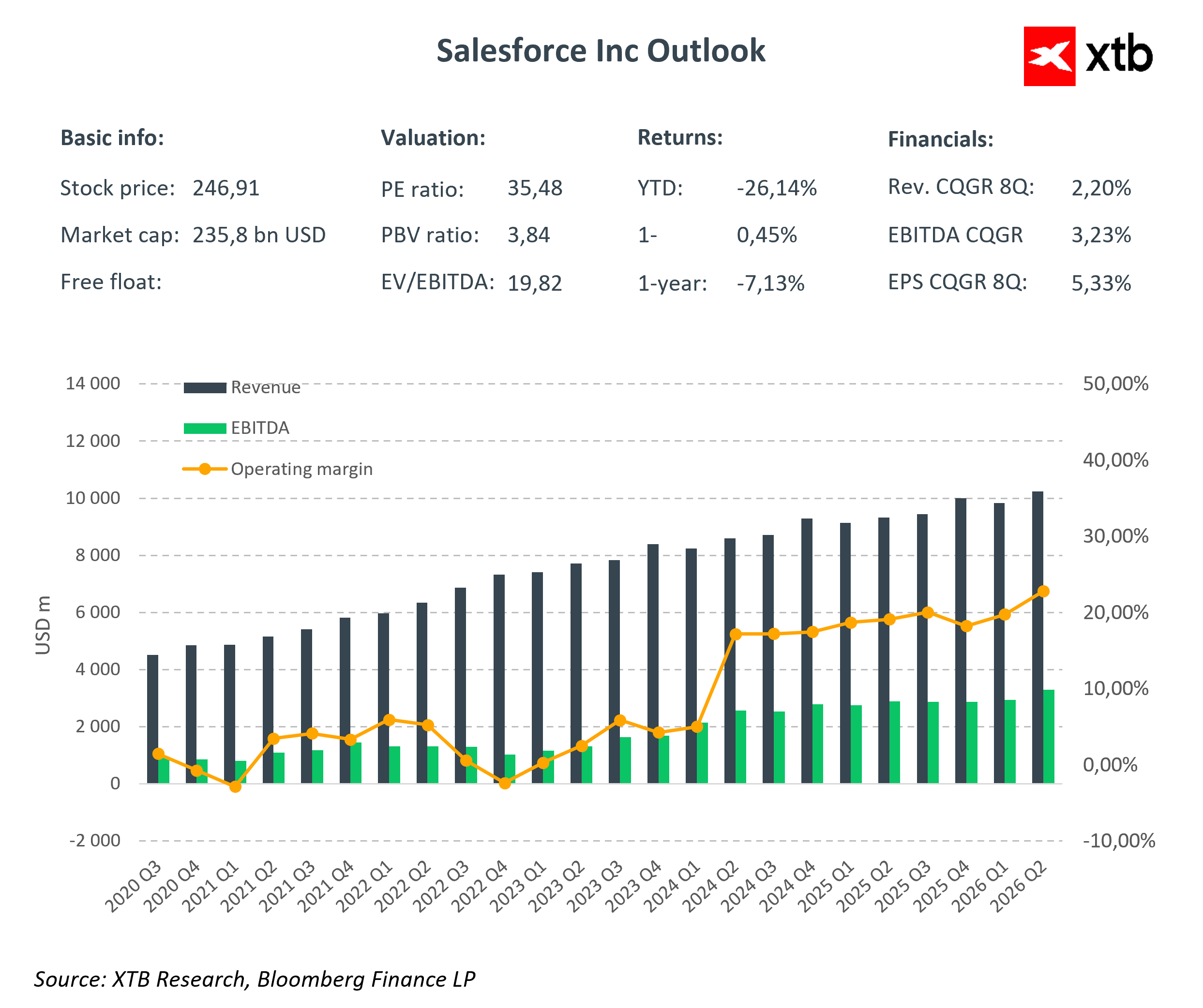
Salesforce has recorded steady and significant financial growth over recent years. Revenues grew from $26 billion in 2022 to nearly $38 billion forecasted for fiscal 2025, reflecting increasing scale and successful market expansion. EBITDA also increased dynamically from around $5 billion to over $11 billion, signaling improved operational efficiency and better cost management.
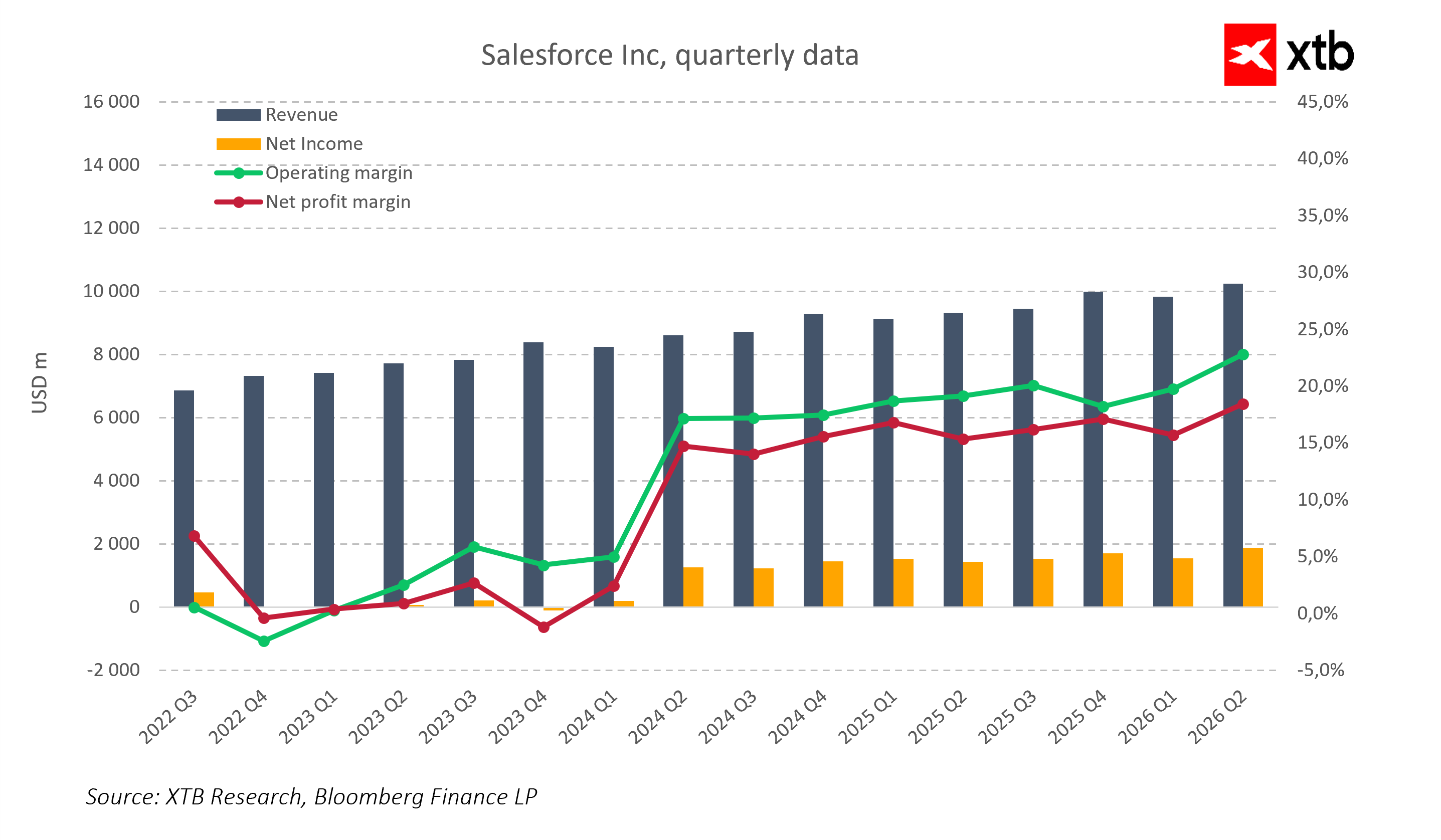
A key change is a significant margin improvement: operating margin rose from about 7% in 2022 to 18% in 2025, and net margin from 6% to 15%. This results mainly from more efficient use of fixed costs at a larger scale and optimized operational expenses, supported by automation and better IT infrastructure management.
Additionally, the growth of subscription-based cloud services (SaaS) ensures stable and predictable revenues with relatively low cost growth. Increasing contributions from more profitable segments, such as AI-based solutions and public sector services, further enhance profitability and strengthen the company’s position in the innovation market.
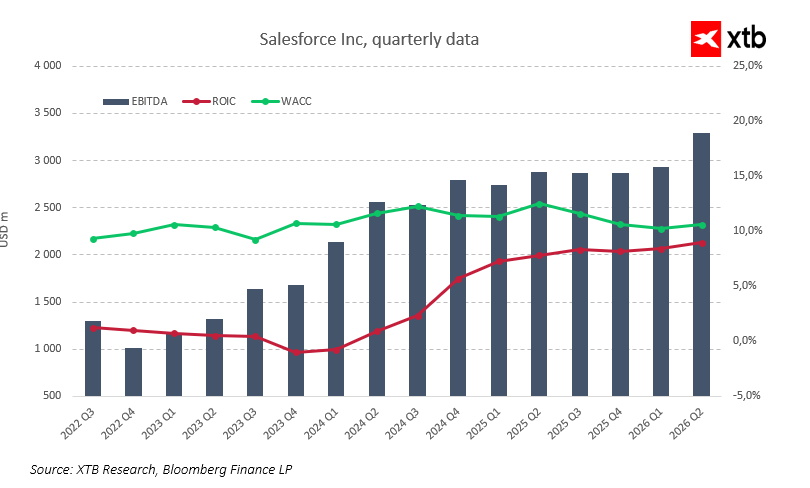
Salesforce’s Return on Invested Capital (ROIC) is undergoing a significant transformation. After low values in 2023, it is steadily rising, reaching nearly 10% in Q2 fiscal 2026. This signals increasingly efficient capital use, generating more shareholder value. Although ROIC still slightly trails WACC, the trend indicates improving financial management quality and growth potential.
Revenue Segment Analysis
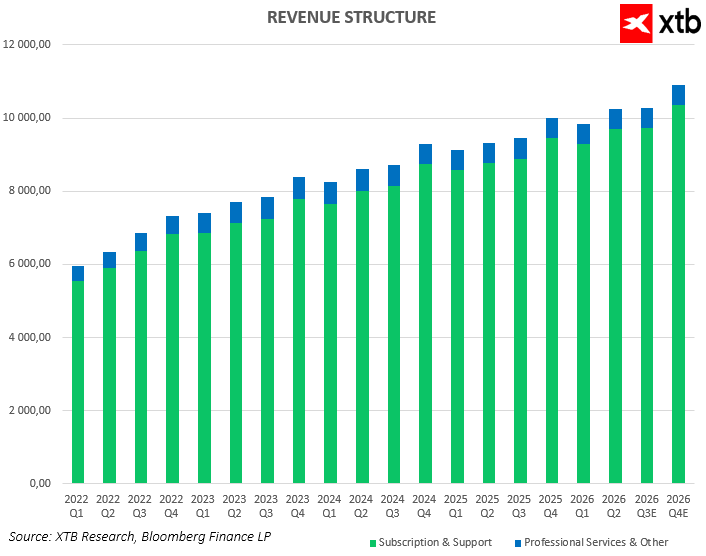
Salesforce’s revenue segmentation points to a well-defined, stable business model primarily based on subscription services. The Subscription & Support segment is the dominant revenue pillar, currently generating over 90% of total income. The Professional Services & Other segment, accounting for about 9-10% of revenues, includes consulting and implementation services, which are supplementary and grow more slowly due to rising automation.
The dominance of the subscription segment reflects Salesforce’s effective strategy focusing on developing cloud CRM solutions and business process automation. New products and business areas, such as AI and security, give the company potential for further revenue growth in coming years. Particularly, the growth of Missionforce will likely significantly expand the offering and open new revenue streams. Entering the national security market and collaborating with government institutions is a step that could greatly increase scale and diversify revenues. This positions Salesforce not only as a CRM leader but also as a key IT solutions provider for the public and defense sectors.
Revenue Forecast

Salesforce is expanding its portfolio with modern technologies and sectors, positively impacting revenue forecasts for the coming years. Subscription services remain the business model’s foundation, providing stable and predictable revenues. At the same time, the company is growing its professional services segment, which, while smaller, is key to implementing and customizing solutions for clients. Salesforce is intensifying investments in AI, automation, and IT security to drive further growth. The development of Missionforce, focused on national security and collaboration with the U.S. government, is particularly important, opening access to multi-billion-dollar contracts and enabling revenue diversification.
The forecast analysis outlines three growth scenarios:
-
Base scenario: Revenues grow steadily from about $31 billion in 2023 to around $69 billion in 2030. This anticipates dynamic growth in the subscription segment, moderate growth in professional services, and gradual adoption of new AI and security technologies. Growth momentum slows as the market matures.
-
Optimistic scenario: Faster growth in AI and security segments and increased government contract involvement via Missionforce. Revenues could exceed $76 billion by 2030, driven by rising demand for advanced cloud, AI, and cybersecurity solutions. Synergies among business segments will be important.
-
Conservative scenario: Slower growth with 2030 revenues around $58 billion. This factors in risks such as increasing competition, regulations, and delays in innovation deployment. Additionally, Salesforce may struggle to fully monetize new areas like AI and national security, limiting growth and resulting in moderate expansion.
Valuation Overview
We used a discounted cash flow (DCF) method to value Salesforce. This valuation is for informational purposes only and should not be taken as investment advice or a precise target price.
We applied the base scenario, assuming gradual revenue growth deceleration due to market maturity and increased competition. The model considers varied dynamics in key segments, with subscriptions dominant. We expect this segment to continue stable growth but at a declining pace. The weighted average cost of capital (WACC) was preliminarily estimated at 10%, expected to slightly decrease over time due to improved risk profile and financial stability. Terminal value assumes a conservative 2% annual revenue growth, and other parameters rely on average financial results over the past five years.
The valuation yielded $326.98 per share, indicating roughly 30% upside from the current closing price of $246.91. The company consistently expands its portfolio, develops subscription and support segments, and invests in new areas like AI and national security. This opens entirely new revenue sources and allows diversification.
Despite significant growth potential, Salesforce faces challenges such as rising competition, regulations, and difficulties in fully monetizing new segments, which may slow growth. Nevertheless, Salesforce has the chance to strengthen its position not only as a CRM leader but also as a key IT solutions provider for the public and defense sectors.
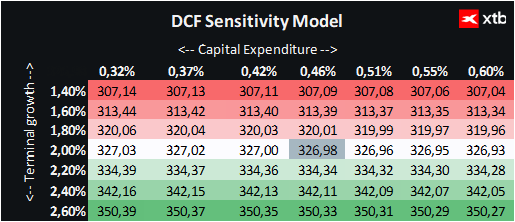
Chart Overview
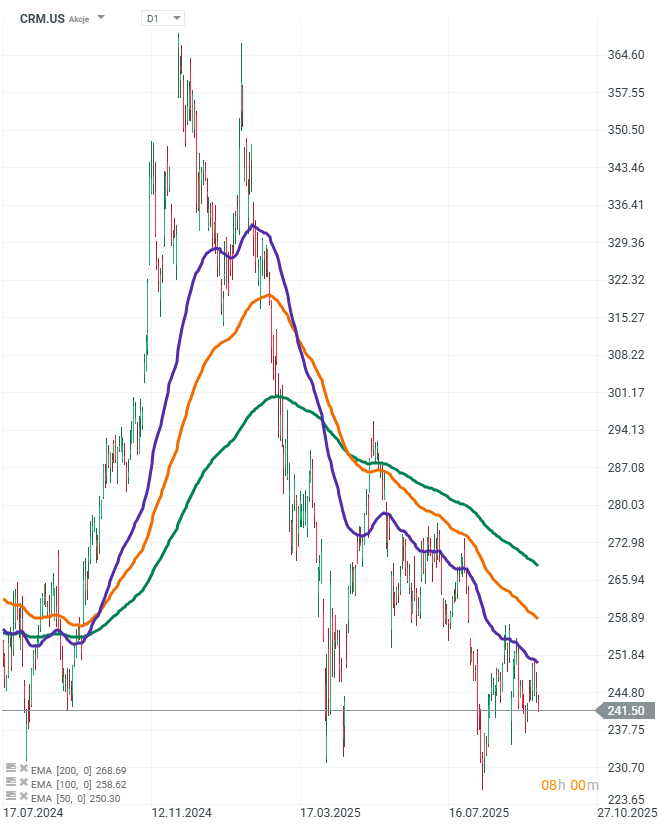
Source: xStation5
Salesforce shares are exhibiting a strong downward trend. All key moving averages are significantly above the current market price. Technically, this may indicate continued downward pressure in the short term. However, from a long-term investor's perspective, it could present an opportunity — especially in light of the company’s solid fundamentals, growth forecasts, and the development of new segments related to AI and national security.
Daily summary: Optimism on Wall Street eases again🗽US Dollar drops from recent highs
Coffee futures drop as huge Brazilian shipping to Europe eases supply concerns
Cocoa falls 3% amid improving crops in West Africa
Crypto decline amid weak sentiments on Wall Street 📉
This content has been created by XTB S.A. This service is provided by XTB S.A., with its registered office in Warsaw, at Prosta 67, 00-838 Warsaw, Poland, entered in the register of entrepreneurs of the National Court Register (Krajowy Rejestr Sądowy) conducted by District Court for the Capital City of Warsaw, XII Commercial Division of the National Court Register under KRS number 0000217580, REGON number 015803782 and Tax Identification Number (NIP) 527-24-43-955, with the fully paid up share capital in the amount of PLN 5.869.181,75. XTB S.A. conducts brokerage activities on the basis of the license granted by Polish Securities and Exchange Commission on 8th November 2005 No. DDM-M-4021-57-1/2005 and is supervised by Polish Supervision Authority.


